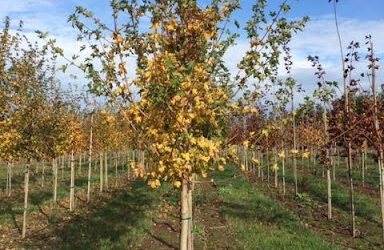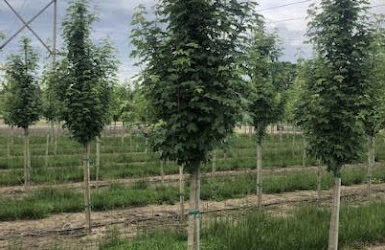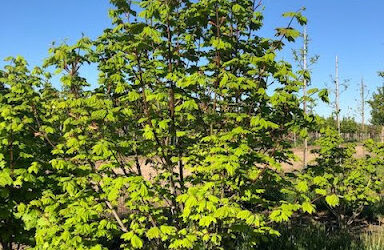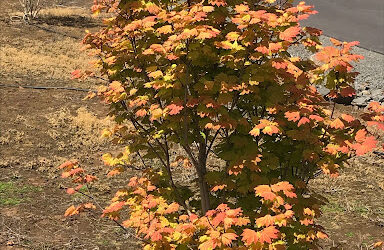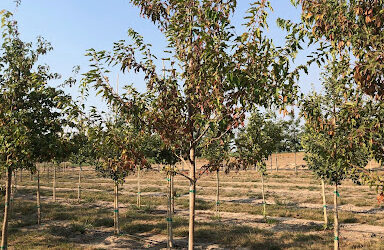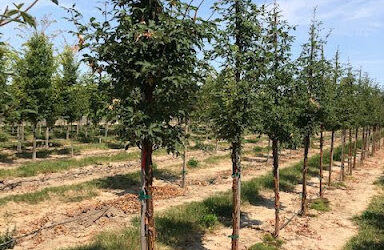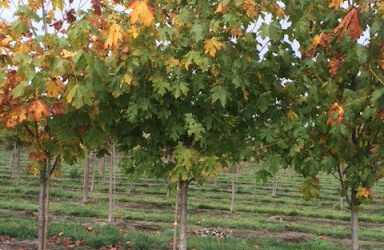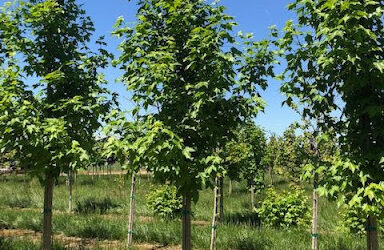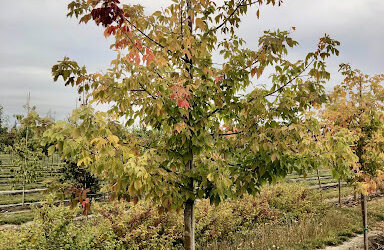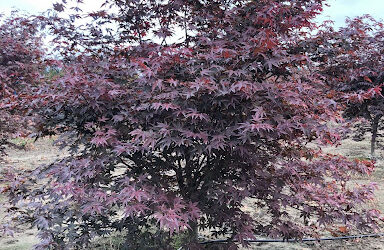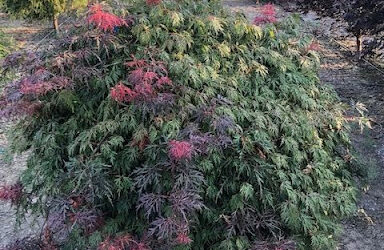Acer campestre – Hedge Maple
Botanical Name: Acer campestre
Alternate name: Field Maple
The Hedge Maple (Acer campestre) is native to Europe and Western Asia. This tree is a small, low branched, densely rounded, deciduous tree. As the name suggests, it may be pruned to form a tall hedge.
In England it is often found growing in hedgerows along streams and in fields. However, over time this tree can also be trained to reach 100 feet tall!
Acer campestre likes full sun but thrives in part shade, particularly as a young tree. It prefers moist, well-drained soil but tolerates clay. The Hedge Maple is tolerant of urban environments and some pollution. Its low mature height is good for planting under power lines. This tree is somewhat tolerant of salt and can therefore be used near driveways and sidewalks.
The Hedge Maple has bark which is an attractive brown-gray in color with vertical furrows, and the twigs are brown with opposite buds. The leaves of Acer Campestre have 3-5 lobes, with a typical maple palmate shape and are mid- to dark green in color.
In May, tiny yellowish-green flowers hang down from the branches in clusters. They are followed in summer and fall by the fruits, which are two-winged nutlets, whose wings have a spread of almost 180 degrees. The leaves turn an attractive yellow or red color in fall.
Acer campestre ‘Evelyn’ – Queen Elizabeth™ Hedge Maple
Botanical Name: Acer campestre ‘Evelyn’
Alternate Name: Evelyn Hedge Maple
The Queen Elizabeth Hedge Maple grows to 30 feet tall and 30 feet wide. Its growth habit is low to the ground, with the lowest branches being around 4 feet above the ground. The size prohibits it from being planted under power lines. Acer campestre ‘Evelyn’ is slow growing, and under optimum conditions can live up to 80 years or longer.
This tree grows more vigorously than the species form. Acer campestre ‘Evelyn’ can be distinguished from the species in a few ways:
- An upright branching habit which is distinct to ‘Evelyn’. The branches grow at a 45 degree angle from the tree trunk.
- Larger leaves – up to 5 inches long and 4 inches wide in its second year and dark green in color. They have 3-5 lobes.
- Fast growth rate in the first year, which slows later.
Acer campestre ‘Evelyn’ flowers in the spring with insignificant, yellowish-green blooms. The blooms are followed by winged samaras (up to 1 3/4 inches long), which grow horizontally. The leaves develop various shades of yellow in the fall. The petioles of the leaves contain milky sap.
The Queen Elizabeth Hedge Maple thrives in urban environments and is very tolerant of pollution.
Acer circinatum – Vine Maple
Botanical Name: Acer circinatum
Alternate Name: Pacific Northwest Native Maple
The Vine Maple (Acer circinatum) is native to western North America. It is found growing in the coastal forest understories beneath much larger trees, such as Douglas firs and Big Leaf Maples, from northern California to southwest British Columbia.
This tree can be found in clearings and grows at altitudes from sea level to 4,900 feet. It is often found along rivers, growing close to the water or beneath conifers, lighting up the dappled shade with its beautiful yellow foliage in the fall.
The Vine Maple’s usual form is a multi-trunked, large shrub or tree. It grows from around 16 to 26 feet tall but occasionally will grow into a small or medium-sized tree, reaching 50 feet. The shoots are slender and hairless.
The Vine Maple, although not really a vine, is so-called because it has very slender, often sprawling, branches. The branching habit produces an elegant, tiered effect. These branches often root to produce new trees, creating dense thickets underneath the shade of taller conifers. Its botanical name ‘Circinatum’ refers to the rounded, although regularly lobed, maple leaves.
Vine Maple trees are flexible, and their growth can bend back towards the ground. Sometimes the branches will root and develop a new root system. This characteristic makes it the only maple capable of layering (producing a new plant while still attached to the ‘mother’ plant).
Flowers of deep red and white grow along branches in the spring, contrasting with the red sheaths covering the leaf buds, and providing a colorful show in the garden. The new reddish woody growth also brings interest in spring, and it is followed by soft green leaves. The Vine Maple’s fall color can vary widely from light yellow in the shade to bright orange or red when grown in sunnier locations.
Acer circinatum ‘Pacific Fire’ – Pacific Fire Vine Maple
Botanical Name: Acer circinatum ‘Pacific Fire’
Acer circinatum ‘Pacific Fire’ or Pacific Fire Vine Maple was selected for its bright red twigs that fade to glowing orange. These bright colors are more pronounced in younger trees but can also be seen in older trees, with bright red branch tips fading to orange as it progresses down the tree. This provides the tree with radiant bright fall and winter color. The fall color lasts for the season, providing a beautiful display.
Acer circinatum ‘Pacific Fire’ also provides beautiful foliage color in the fall. Its leaves change from light green or pale yellow, depending upon exposure in spring and summer, to various shades of bright yellow, burnt orange, red, and burgundy. These trees will provide a seasonal display that will not disappoint.
This cultivar often only reaches 10 feet tall and 6 feet wide, making it a perfect specimen for a smaller landscape. It has many of the great features of Japanese Maples, such as colorful twigs and fall color, but is much more adaptable and easier to grow. The Pacific Fire Vine Maple can be planted as an understory tree beneath larger maples and conifers to create a beautiful Pacific Northwest landscape.
Acer ginnala ‘Flame’ – Flame Maple
Botanical Name: Acer ginnala ‘Flame’
Common Names: Flame Amur Maple, Amur Maple
Acer ginnala (Amur Maple) is native to the forested areas of southeastern Europe and western Asia. A selection of Acer ginnala was made by the USDA in 1978 for its fiery red autumn color, and Acer ginnala ‘Flame’ aka Flame Maple was created. It has all the fine characteristics of Acer ginnala, as well as outstanding fall color. The Flame Amur Maple is also grown for its highly ornamental fruit, although its flowers are not ornamentally significant.
This smaller ornamental maple often grows as a multi-trunked shrub or tree, as well as a standard form, and is useful as a hedge, as well as ornamental tree. It grows to around 20 feet tall at its largest and has a beautiful, open growth habit with a rounded crown.
The Flame Maple tree can thrive in most conditions in both residential or commercial locations. It is not particular to any pH or soil type. It can even survive in high-stress environments, such as planted as a street tree where it is exposed to urban pollution.
This particular maple cultivar features:
- Multi-trunked or trained into a standard form.
- Abundant showy scarlet samaras in late summer.
- Attractive, lobed, dark green foliage throughout spring and summer.
- Intense fall color, when the leaves turn an outstanding shade of scarlet.
- Adaptable to both moist and dry conditions.
- Tolerant of drought conditions.
Acer griseum – Paperbark Maple
Botanical Name: Acer griseum
Acer griseum (Paperbark Maple) is native to central China and is found growing in mixed evergreen and deciduous forests. E.H Wilson brought this tree from China to England in 1899. It was introduced to the U.S. shortly thereafter by the Arnold Arboretum of Harvard University.
The Paperbark Maple is an easy to grow, small, deciduous maple. Its main feature is its beautiful, peeling, cinnamon-colored bark. Its foliage is also striking, with its dark green, trifoliate leaves between 3 and 5 inches long. The leaves have white undersides, which turn bright orange or red in the fall. Its botanical name ‘Griseum’ means gray, referring to the color of the leaf undersides.
The exfoliating bark that stays curled on the trunk and branches is such an attractive, eye-catching feature that it should be featured as a specimen tree in gardens. It can also be planted as a foundation tree – planted close to a home to fully appreciate its fall and winter charms.
The Paperbark Maple’s flowers are insignificant, but they are followed by noticeable samara’s up to 1/4 inches long.
The Paperbark Maple is ideal for shading outdoor living spaces, such as patios or decks or as a front yard accent or street tree. This desirable tree works well in wilder, wildlife gardens and in wetland conditions. It is hard to propagate, with only 5% of its seed viable. The Paperbark Maple has no serious insect or disease problems.
Acer macrophyllum – Bigleaf Maple
Botanical Name: Acer macrophyllum
Acer macrophyllum or Bigleaf Maple is a graceful and stately tree that grows to be moderate to large in size. It matures to a height and spread of 40-80 feet but sometimes will reach 100 feet tall. As this tree grows, it develops a beautiful oval or rounded crown. The bark is deeply furrowed on mature trees and is an attractive gray to reddish brown color.
The Bigleaf Maple is native to Oregon and other states up and down the Pacific Coast, from California to British Columbia. This tree is commonly found growing in mixed evergreen forests but rarely more than 200 miles east of the ocean. It is tolerant of different conditions and is found growing in both wet and dry areas. Acer macrophyllum is one of only two species of native maple that are in cultivation, the other being the Vine Maple (Acer circinatum).
The Bigleaf Maple is so-called because of its large leaves that can reach up to 12 inches in size. The species’ Latin name literally means big leaf: macro = big and phyllum = leaf. This maple has beautifully dark green leaves that have five or occasionally three lobes.
The leaves emerge in spring with a purple tinge and then mature to dark green throughout the summer. This maple can be seen brightening the forests and hillsides of the Pacific Northwest, putting on a lovely yellow and orange display in fall.
The greenish-yellow flowers grow clustered along pendulous stalks, about 4-8 inches long. They appear in April or May and attract many native pollinators such as bees and other insects. The winged samaras that follow them feed small mammals and songbirds.
Acer miyabei ‘Morton’ State Street -State Street® Maple
Botanical Name: Acer miyabei ‘Morton’ STATE STREET
Alternate Name: Miyabe Maple
The State Street® or Miyabe Maple is named after the botanist Kingo Miyabe who discovered the parent tree of this species. He found it growing on the Japanese island of Hokkaide. This maple is native to a few northern regions of Japan, where it is endangered. It is mostly found growing near streams.
Acer miyabei ‘State Street’ was first grown in the US in the well-known Morton Arboretum in Illinois in 1988, and the cultivar was selected from this tree. The original specimen was planted in 1929 and has grown to a size of 60 feet.
In general, the State Street® Maple grows up to 40-45 feet in height and 30-35 feet in width. It has a beautiful rounded or oval shape and attractive uniform branching which forms a good scaffold structure. Its canopy is denser than most other maple species.
This tree develops yellowish-green small flowers in clusters in the spring which don’t contribute to its ornamental impact. At the same time, the lustrous 5-lobed new leaves unfurl medium to dark green. These develop a beautiful, rich, golden yellow in autumn.
The bark of the State Street® is thick and cork-like, and it has vertical furrows similar to the Hedge Maple. It helps the tree resist sunscald.
The State Street® Maple is a great choice for difficult conditions. It is highly adaptable and tolerates urban pollution extremely well, not to mention heat and cold and alkaline or acid soil conditions.
Acer negundo ‘Sensation’ – Sensation Box Elder
Botanical Name: Acer negundo ‘Sensation’
Alternate Name: Manitoba Maple
The Sensation Box Elder (Acer negundo ‘Sensation’) is said to have been discovered by nurseryman Warren Carnefix in Idaho around 40 years ago, when he glimpsed it in an abandoned lot whilst driving by.
The Sensation Box Elder is a hardy, tough tree that has year round interest. The species Box Elder is native to much of the US and Canada. Its fall color is an unimpressive yellow. However, the ‘Sensation’ Box Elder variety puts on a showy autumn display of bright red and orange leaves.
In the spring, this tree also has beautiful color with the new leaves emerging in a bronze-orange glow. The leaves then mature to an attractive mid-green color but keep highlights of red until the fall display occurs.
The leaves are pinnately compound, with 3-5 leaflets that are sharply-toothed. The flowers are inconspicuous and don’t contribute to the charm of the tree.
This tree has a more regular and compact shape than its parent Acer negundo. It is a male clone so does not produce fruit clusters. This is useful to prevent attracting the box elder bug, which will feed on the flowers of the female tree species.
Prune in late winter/early spring to promote air circulation in the canopy. Easy to care for. Plant with Japanese Maples to achieve a variety of leaf textures and fall color.
Acer palmatum ‘Bloodgood’ – Bloodgood Japanese Maple
Botanical Name: Acer palmatum ‘Bloodgood’
Alternate Name: Bloodgood Maple
The Bloodgood Japanese Maple (Acer palmatum ‘Bloodgood’) is a popular landscaping choice for a small red/purple-leaved Japanese Maple tree or large shrub. This tree is grafted. The attractive foliage consists of 5-7 pointed lobes, and the color is a very deep-red, which deepens to purple later in the summer.
Bloodgood Japanese Maple then develops a beautiful crimson fall color. It is a vigorous, sturdy, and dependable tree, with an upright form and a rounded crown that spreads wider with age. The tree develops graceful, horizontal branching.
The foliage can burn in the sun in hot areas or with insufficient irrigation, so some afternoon shade is preferable. Foliage color develops a richer hue in the shade. In cooler areas, Acer palmatum ‘Bloodgood’ will flourish in full sun.
The Bloodgood Japanese Maple offers interest year-round. It develops beautiful, red-purple flowers in the spring. These are followed by eye-catching fruits, which are brilliant red-colored samaras (winged fruit) that look stunning against the tree’s gray bark and new purple twigs. After the flower and fruit display, the new reddish purple leaves unfurl and cover and develop a canopy.
Bloodgood Maple roots appreciate mulching to keep the roots cool and conserve moisture. These trees are low maintenance and require little pruning.
Acer palmatum ‘Emperor 1’ – Emperor 1 Japanese Maple
Botanical Name: Acer palmatum ‘Emperor 1’
Alternate Name: Emperor Maple
The Emperor 1 Japanese Maple (Acer palmatum ‘Emperor 1’) is a desirable small shade tree. It leaves out two weeks later than most maples, thereby avoiding any frost damage to new growth.
This particular Japanese Maple keeps its leaf color best in partial shade. The foliage has an enticing glow for most of the year. The leaves emerge bright red in spring, and then mature into a beautiful, deep red-purple color. They are delicate and palmate-shaped, with 5 deeply divided lobes.
Emperor 1 Japanese Maple holds its delightful color through the summer, glowing in the sunlight, and then puts on a spectacular bright scarlet fall display that will not disappoint. The flowers are inconspicuous and not noticeable compared to the leaves.
The Emperor Maple grows fairly fast, reaching 8-10 feet tall in 10 years. It is therefore a good tree to plant where a fast-growing landscape is needed. Also, be sure to plant where it will be protected from harsh winds and hot afternoon sun.
It has a graceful, upright, open crown but compact form. This makes it a good accent tree for small landscapes.
The Emperor 1 Japanese Maple doesn’t need much pruning. Make sure to prune in late winter or early spring before the sap starts running. Mulch around the base of the tree to keep soil moist and the roots cool.
Acer palmatum dissectum ‘Crimson Queen’ – Crimson Queen Japanese Maple
Botanical Name: Acer palmatum dissectum ‘Crimson Queen’
Alternate Name: Crimson Queen Laceleaf Japanese Maple
This beautiful Laceleaf Japanese Maple is highly sought after. The ‘Crimson Queen’ Japanese Maple has an attractive weeping form with dense, low branching. As it matures, it slowly reaches a height and width of 8-10 feet as it grows to form a wide mound. It will reach its mature size in 10-20 years.
Acer palmatum dissectum ‘Crimson Queen’ Japanese Maple is a lace-leaf maple. This means that the leaves are delicately and deeply divided. This tree provides the perfect fine-textured addition to an Asian-themed garden or woodland yard. Mix with coarser-textured trees and shrubs.
The foliage emerges a bright green in spring with purple edging and small deep pink flowers in April. The leaves mature to a rich, deep red, and they keep their color throughout the summer. Sunlight enhances its bright color. The tree then turns a bright crimson in the fall for a fabulous seasonal display. Along with the vibrant leaves, the winged samaras also develop from green to orange in September and October, arriving at a vivid bright red to enhance the colorful fall foliage.
Crimson Queen Japanese Maple can tolerate full sun in cooler regions but prefers some shade in hotter areas. Plant in dappled shade as an understory tree or on the north side of your property to protect the foliage from harsh afternoon sun.
Acer palmatum dissectum ‘Orangeola’ – Orangeola Japanese Maple
Botanical Name: Acer palmatum dissectum ‘Orangeola’
Alternate Name: Orangeola Laceleaf Japanese Maple
Orangeola Japanese Maple (Acer palmatum Dissectum ‘Orangeola’) is a stunning landscape tree for all seasons. Its form is semi-upright and weeping. It is extremely tolerant to full sun exposure. This tree’s foliage goes through a variety of changes throughout the growing season, and its graceful form provides structure to the landscape in winter.
Like other lace-leaf maples, the Orangeola Japanese Maple provides beauty for courtyards, gardens, and containers. The fine textured foliage contrasts beautifully with dark green and blue conifers. Together they can form a stunning Pacific Northwest landscape.
Unlike other weeping Japanese Maples – whose growth pattern is to spread wider than they grow tall – the Orangeola Japanese Maple has a relatively modest spread of 3-7 inches. It can grow up to 8 feet tall. It is therefore more suitable for planting in containers than other lace-leaf maples, and it forms a wonderful specimen on porches or patios.
In spring, the new growth emerges a bright orange or red. With a second flush of new growth, the tree can then take on a multi-colored appearance. It develops orange new growth, and the older leaves take on green or maroon hues. When summer comes, the foliage develops an attractive green color with orange and red highlights. In fall, ‘Orangeola’ continues its color changes and develops bright flaming red and burnt orange colors for a powerful display.
Acer palmatum dissectum ‘Seiryu’ – Laceleaf Japanese Maple
Botanical Name: Acer palmatum dissectum ‘Seiryu’
Alternate Name: Seiryu Maple
The Laceleaf Japanese Maple or Seiryu Japanese Maple grows in an upright growth habit, whereas other Japanese Maple cultivars with dissected leaves develop a weeping habit. ‘Dissectum’ refers to the deeply divided, palmate ornamental leaves 2 inches long that are reminiscent of fern leaves in their intricacy. The leaves on this cultivar are smaller than those of other dissected leaf maples.
The leaves of the Laceleaf Japanese Maple unfurl an attractive chartreuse color with red tips in the spring. The flowers of deep red/purple then emerge above the foliage in mid-spring and are pretty but not showy. The leaves later mature to a light green with a red tinge. In autumn, they turn an assortment of eye-catching colors of red, orange, and yellow.
Acer ‘Seiryu’ develops red samaras in the early to mid fall. The bark is an attractive gray color, and the tree silhouette provides structural interest through the winter. The cultivar name ‘Seiryu’ means blue-green dragon. Under optimal conditions it can live for up to 80 years.
Plant the Laceleaf Japanese Maple in full sun to part shade, but the foliage color is best with partial shade. This maple cultivar appreciates some shelter from the elements, as the leaves can suffer from wind and sun burn. The soil should be kept moist and compost should be added on a yearly basis. It’s important to mulch around the base of this tree to keep the roots moist and cool.
Acer palmatum dissectum ‘Tamukeyama’ – Tamukeyama Japanese Maple
Botanical Name: Acer palmatum dissectum ‘Tamukeyama’
Alternate Name: Tamukeyama Laceleaf Japanese Maple
Tamukeyama Japanese Maple (Acer palmatum dissectum ‘Tamukeyama’) is a beautiful, cascading, dwarf Laceleaf Maple. The name ‘Tamukeyama’ means ‘hands folded in prayer on the mountain,’ which refers to its mounding growth pattern. It is a reliable grower and can reach 10 feet tall and 12 feet wide. This tree is an old cultivar, thought to date back to the 1700s.
The foliage of the Tamukeyama Japanese Maple holds a rich, deep burgundy color throughout the growing season. It is more cold tolerant than other Laceleaf Maples and also heat tolerant. The delicate, deeply divided foliage tolerates humid heat better than other Laceleaf Maples and rarely scorches. However, it should be planted in dappled shade or shade for optimal growth.
Another attractive feature of the Tamukeyama is its deep red bark. This feature nicely compliments the purple foliage and shows off the tree’s weeping form in winter, when the leaves have fallen.
This specimen puts on a spectacular display in fall, when its foliage changes from purple to bright, fiery crimson. The Tamukeyama Japanese Maple is a great addition to Asian-themed gardens or planted near fountains or other water features. It thrives in containers and also works well in planting beds in woodland settings – mixed with colorful shade shrubs and perennials.

